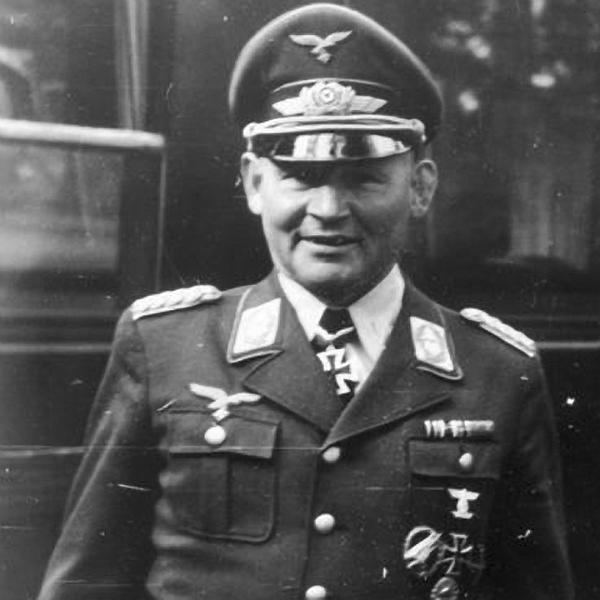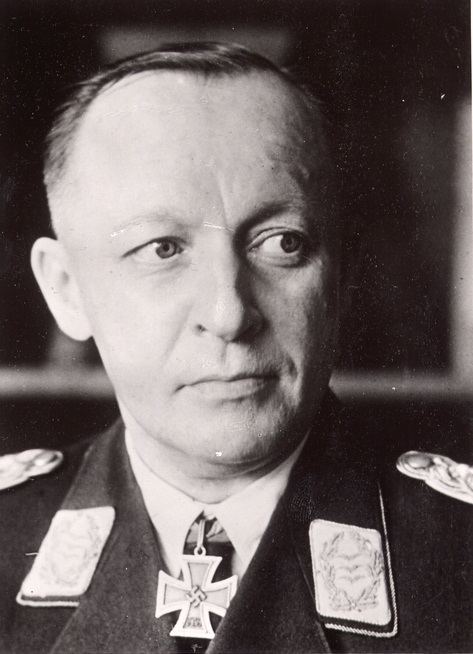Years of service 1910–45 Rank Generaloberst | Name Kurt Student | |
 | ||
Battles/wars World War IWorld War II Commands held 1st Parachute Division, XI. Fliegerkorps, 1st Parachute Army Similar People Walter Model, Gerd von Rundstedt, Bernard Freyberg - 1st Baron, Albert Kesselring, Wilhelm Bittrich | ||
Kurt Student (12 May 1890 – 1 July 1978) was a German paratroop general in the Luftwaffe during World War II. He launched the first major airborne operation of the war, the Battle for The Hague in May 1940. The highest-ranking member of Germany's parachute infantry, Student commanded the Fallschirmjäger throughout World War II. In 1947, Student was tried and convicted of war crimes committed while in command on Crete.
Contents

World War I and inter-war years

Student entered the Prussian Army as a Fähnrich in 1910 and was commissioned a lieutenant in March 1911. He qualified as a pilot in 1913 and served during World War I. In July 1916, he became a charter member of the Fokker Scourge, when he scored his first confirmed victory, forcing Nieuport 11 no. 1324 to land behind German lines. He then served in aerial units of the Third Army on the Western Front, including Jagdstaffel 9 (Jasta 9), which he commanded from 5 October 1916 – 2 May 1917, when he was wounded. He scored six air-to-air victories over French aircraft between 1916 – 1917, with two coming after his wound. He left Jasta 9 on 14 March 1918.

In the immediate post-war years, Student was assigned to military research and development. He became involved in military gliders, since gliding was not forbidden by the Treaty of Versailles. He also attended the Red Army Air Forces maneuvres, where he first came in contact with the idea of airborne operations. After Adolf Hitler came to power in Germany, the Luftwaffe was secretly reestablished. Student transferred from the Army to the air force and was appointed by Hermann Göring to be the head of its training schools. In July 1938, he was named commander of airborne and air-landing troops, and in September commanding general of the 7th Air Division, Germany's first paratroop division.
World War II
The division played no part in the invasion of Poland. In their first action, his troops failed to achieve even the least of their objectives in the Battle for The Hague on 10 May 1940, taking and losing three airfields on the first day of the battle (an operation in which the German air force also incurred enormous losses). Student was almost taken prisoner there, and was shot in the head - it was later determined to be a stray German round - in Rotterdam following the Battle of Rotterdam. His capture was halted only when Rotterdam was bombed on 14 May. He was decorated with the Knight's Cross of the Iron Cross for his leadership and bravery in the operation to capture the Belgian fortress of Eben-Emael.
In January 1941, Student was named commanding general of the XI. Fliegerkorps, the newly formed command for the expanding German airborne forces. In this capacity, Student directed Operation Mercury (Unternehmen Merkur), the airborne invasion of the island of Crete in May 1941. Crete was taken, but the high casualties caused Hitler to forbid future airborne operations. Acting as the temporary commander of the island, immediately after the surrender of Crete on 31 May 1941, on Göring's order Student issued an order for a launching of a wave of brutal reprisals against the local population with the Massacre of Kondomari and the Razing of Kandanos being typical examples. His actual order read:
It is certain that the civilian population including women and boys have taken part in the fighting, committed sabotage, mutilated and killed wounded soldiers. It is therefore high time to combat all cases of this kind, to undertake reprisals and punitive expeditions which must be carried through with exemplary terror. The harshest measures must indeed be taken and I order the following: shooting for all cases of proven cruelty, and I wish this to be done by the same units who have suffered such atrocities. The following reprisals will be taken:
1. Shooting
2. Fines
3. Total destruction of villages by burning
4. Extermination of the male population of the territory in question
My authority will be necessary for measures under 3 and 4. All these measures must, however, be taken rapidly and omitting all formalities. In view of the circumstances the troops have a right to this and there is no need for military tribunals to judge beasts and assassins.
In 1943, Student ordered Major Harald Mors to plan Operation Oak (Unternehmen Eiche), the successful raid conducted by a special Fallschirmjäger unit to free Italian dictator Benito Mussolini. They landed with gliders and STOL aircraft on a hilltop. Student received the Oak Leaves to the Knight's Cross of the Iron Cross for his role in the operation.
Student was transferred to Italy and later to France, where he was involved in the battles of Normandy in 1944. He was put in charge of the First Paratroop Army and took part in countering the Allied Operation Market Garden, near Arnhem. After a brief time at the Eastern Front in Mecklenburg in 1945, he was captured by British forces in Schleswig-Holstein in April of that same year, before he could take command of Army Group Vistula.
War crimes conviction
In May 1947, Student was put on trial on eight charges of mistreatment and murder of prisoners of war by his men in Crete (but not his crimes against the civilian population of Crete, like those at Kondomari, Alikianos and Kandanos). He was found guilty of three charges, but avoided a stern punishment owing to the testimony of Brig. Inglis, commander of the 4th NZ Brigade. Student was sentenced to five years of imprisonment but was given an early discharge in 1948 due to medical reasons. He died in 1978.
